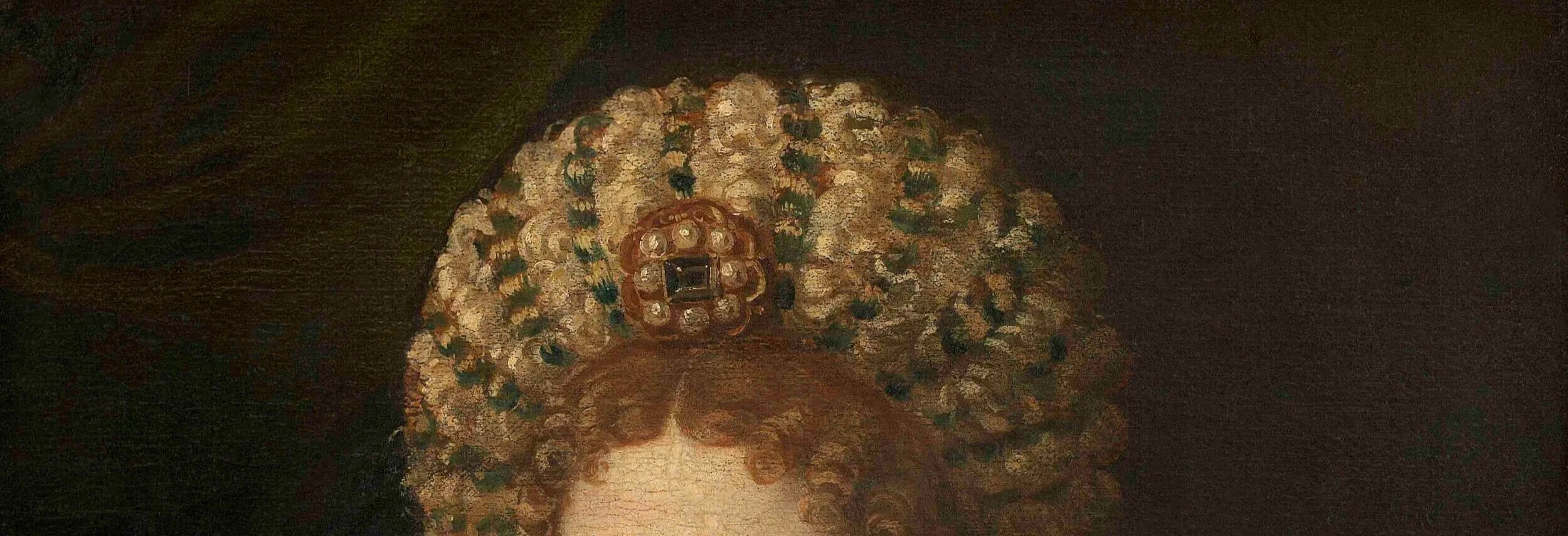Headdress (Zazara)
Fig. 1. Isabella’s zazara. Detail of Titian, ca. 1534-36. Isabella d’Este, Marchesa of Mantua. Canvas, 102.4 x 64.7cm © KHM-Museumsverband.
Titian’s retrospective portrait of the sixty-year-old Isabella d’Este (c. 1534-36, sometimes known as Isabella in Black) depicts an idealised Isabella in her youth, but anachronistically updates her costume. This includes Isabella’s distinctive headwear: the elaborate zazara headdress of her own design (Fig. 1). By the time of Titian’s painting, the zazara (or capigliara) had become a signature item of the dowager marchesa’s wardrobe. It is also worn, for example, by the older Isabella depicted in Titian’s lost Isabella in Red (as seen in Rubens’ copy in the Kunsthistorisches Museum) and in Giulio Romano’s portrait of Isabella’s new daughter-in-law Margherita Paleologa wearing an Isabellian ensemble (Fig. 2).
The zazara was a cleverly-designed piece of millinery, constructed of silk, real or artificial hair, and jewels [1]. The headdress covered most of the hair, showing the front, neatly parted and with a modest suggestion of lustrous curls. Its turban-like shape and rich materials added height and authority to the silhouette and complemented curves in sixteenth-century fashions. The zazara calls to mind Baldassare Castiglione’s advice to the court lady to make a self-aware judgement in choosing the most proper, flattering and elegant garments, with the artful artlessness that Castiglione would term sprezzatura [2].
The appeal of the zazara led to Isabella receiving requests for details of the style and permission to wear it [3]. Countess Eleonora Rusca wrote to Isabella in 1509: ‘I found out that in Milan certain noblewomen were wearing a new style of silk zazara which is a notable invention of Your Ladyship’s, and […] with great desire I beg that you might consider me worthy of wearing one’ [4]. The popularity of the zazara spread in the subsequent decades, and this type of headdress is shown in a number of portraits of fashionable women by artists such as Bernardino Licinio and Bartolomeo Veneto. Beyond Italy, Isabella’s exclusive headwear was coveted by rulers including the queen of Poland and king of France [5].
As well as being on trend, the zazara could indicate political loyalty to the marchesa and her causes. For instance, as Evelyn Welch has pointed out, Eleonora Rusca’s request to wear the zazara (‘so that I will not seem to be outside the number of your most faithful servants’) could proclaim pro-Sforza support for Isabella’s nephew ousted from Milan by the French [6]. The zazara is an excellent example of the importance of sartorial politics [7], and the role of fashion as an instrument of statecraft and political messaging for Renaissance women. The sharing of Isabella’s trademark pieces such as the zazara could win and signal the favour of those above her, allegiance of her peers, and the desire of those below to do her service, promoting the marchesa’s reputation and her diplomatic agendas at home and abroad.
Sarah Cockram, University of Edinburgh
Fig. 2. Giulio Romano, ca. 1531. Portrait of Margherita Paleologa. Oil on panel, 115.3 x 91cm. Royal Collection Trust © Her Majesty Queen Elizabeth II 2020.
NOTES
[1] ^ Isabella’s zazara in this portrait features a gold brooch with a large central gem surrounded by eight pearls.
[2] ^ Baldassare Castiglione, Il Cortegiano, I, 26, and III, 8.
[3] ^ For more on Isabella as a trendsetter, see Margaret Rosenthal's essay for this project here
[4] ^ Eleonora da Correggio Rusca to Isabella d’Este, Locarno, 1509. Alessandro Luzio and Rodolfo Renier, "Il lusso di Isabella d’Este," Nuova Antologia 147 (1896): 441–469; 148: 294–324; 149: 261–286, 667.
[5] ^ Sarah Cockram, "Isabella d’Este’s Sartorial Politics," in Fashioning Women at the Early Modern Court (1450-1700): Sartorial Politics (Gendering the Late Medieval and Early Modern World), ed. Erin Griffey (Amsterdam: Amsterdam University Press, 2019), 46, 49.
[6] ^ Evelyn Welch, "Art on the Edge: Hair and Hands in Renaissance Italy," Renaissance Studies 23, 3 (2009): 251-253.
[7] ^ On sartorial politics see Griffey (ed.), Fashioning Women.







Patricia Lurati